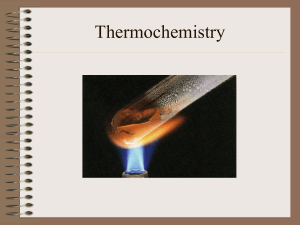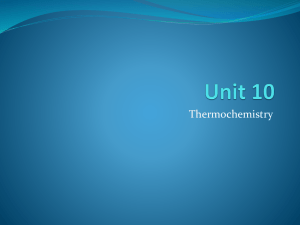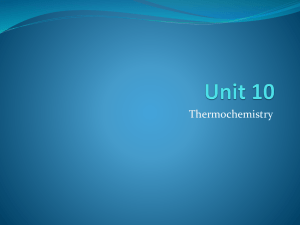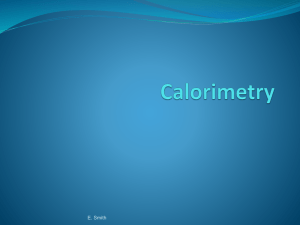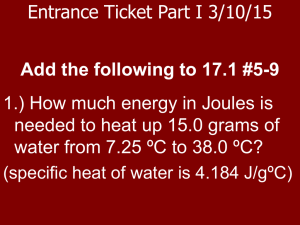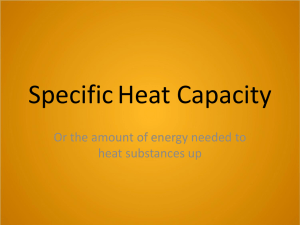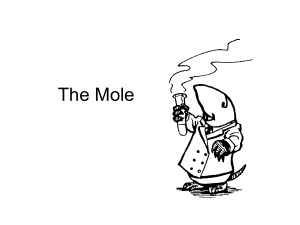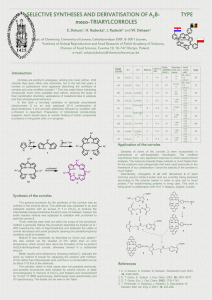Thermochemistry Power point
advertisement
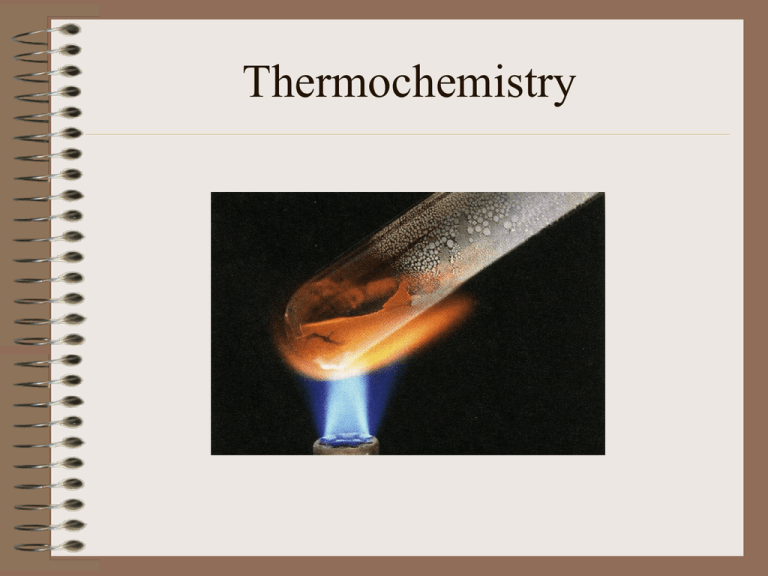
Thermochemistry Definitions • Energy – capacity for doing work or supplying heat. • Thermochemistry – study of energy changes that occur during phase changes and chem. rxns. • Chem. Potential Energy – energy stored in chemical bonds. Example Lots of energy stored in bonds! Energy difference. 5473 kJ/mol Little energy stored in bonds. Heat • Represented by q. • Energy that transfers from one object to another because of a Temp. difference between them. • Heat flows from warm cool until the two objects are at the same Temp. Exothermic vs. Endothermic • In exothermic processes, the system loses heat as its surroundings warm up. – q has a negative value b/c the system is losing heat. • In endothermic processes, the system gains heat as its surroundings cool down. – q has a positive value b/c the system is gaining heat. Potential Energy Potential Energy Diagram of Ice Melting at 0ºC. Water Ice Time Is the melting of ice an endothermic or an exothermic process? How can you tell? Measuring Heat Flow • SI Unit of heat flow: Joule (J) • Common unit used in chemistry: calorie (cal) – Amt. of heat needed to raise 1 gram of water by 1ºC. – 1 cal = 4.184 J • Food Calorie (capital “C”) = 1000 cal, or 1 kilocalorie = 4184 J What do Calories mean in food? • 10 grams of sugar has 41 Calories. – When 10 grams of sugar are burned, 41 kcal (170 kJ) of energy are released. – Your body “burns” food for energy. – In order to use the energy available in 10 grams of sugar, you must do 41 kcal worth of work. Heat Capacity • Amount of heat needed to raise an object’s temperature by 1°C. – Depends on the chemical composition and the mass of the object. • EXAMPLE: 1 gram of water requires 1 cal to raise its temperature by 1°C. – 100. g of water require 100. cal to raise the temp. by 1°C. Heat Capacity Same temperature change 10 g H2O 1 g H2O Specific Heat (c) • Amt. of heat needed to raise 1 gram of a substance’s temperature by 1ºC. – Expressed in J/g ºC, or cal/g ºC • The higher a substance’s specific heat, the more energy it takes to heat it. • Substance’s with low specific heats heat up and cool down quickly (most metals, e.g.) Some Specific Heats Substance Water Grain alcohol Ice Steam Chloroform Aluminum Iron Silver Mercury Specific Heat J/gºC cal/g ºC 4.18 1.00 2.4 0.58 2.1 0.50 1.7 0.40 0.96 0.23 0.90 0.21 0.46 0.11 0.24 0.057 0.14 0.033 Specific Heat (c) • c = heat / (mass x change in Temp.) • c = q / (m x ΔT) • q = m x c x ΔT Example Problem • The temperature of a 95.4-g piece of Cu increases from 25.0ºC to 48.0ºC when the Cu absorbs 849 J of heat. What is the specific heat of Cu? – SOLUTION: q = m x c x ΔT • • • • 849 J = (95.4 g) c (48.0ºC – 25.0ºC) 849 J = (95.4 g) c (23.0ºC) 849 J = (2190 gºC) c c = 0.388 J/gºC • Based on what you know about metals, does this answer make sense? Example Problem • When 435 J of heat is added to 3.4 g of olive oil at 21ºC, the temperature increases to 85ºC. What is the specific heat of olive oil? – SOLUTION: q = m x c x ΔT • • • • 435 J = (3.4 g) c (85ºC – 21ºC) 435 J = (3.4 g) c (64ºC) 435 J = (220 gºC) c c = 2.0 J/gºC Example Problem • How much heat is required to raise the temperature of 250.0 g of mercury by 52ºC? The specific heat of mercury is 0.14 J/gºC. – SOLUTION: q = m x c x ΔT – q = (250.0 g)(0.14 J/gºC)(52ºC) – q = 1800 J = 1.8 kJ Enthalpy Changes • Enthalpy (H) – the heat content of a system at constant pressure. • Enthalpy change (ΔH) – the heat that enters or leaves a system at constant pressure. • q = ΔH • Neg. ΔH = exothermic process • Pos. ΔH = endothermic process Thermochemical Equations • Enthalpy change can be written as a reactant or a product. – Reactant endothermic – Product exothermic • Example: The reaction of calcium oxide with water is exothermic. – It produces 65.2 kJ of heat per mole of CaO reacted. – CaO(s) + H2O(l) Ca(OH)2(s) + 62.5 kJ An Exothermic Reaction CaO(s) + H2O(l) Ca(OH)2(s) + 62.5 kJ CaO(s) + H2O(l) ΔH = -65.2 kJ Ca(OH)2(s) Thermochemical Equations 2NaHCO3(s) + 129 kJ Na2CO3(s) + H2O(g) + CO2(g) Na2CO3(s) + H2O(g) + CO2(g) ΔH = +129 kJ 2NaHCO3(s) Thermochemical Equations and Stoichiometry • You can use thermochemical equations in stoichiometry. – How much heat energy is produced when 55.0 grams of ethanol is burned completely? • • • • C2H5OH(l) + 3O2(g) 2CO2(g) + 3H2O(g) + 1300. kJ Given: 55.0 g C2H5OH Want: kJ Conversion factors: – 1 mol C2H5OH produces 1300. kJ when burned – 1 mol C2H5OH = 46.07 g/mol 1 mol C 2H5 OH 1300. kJ x 55.0 g C2H5OH x 46.07 g C 2H5 OH 1 mol C 2H5 OH = 1550 kJ Thermochemical Equations and Stoichiometry • 0.500 grams of methane gas are burned completely beneath a container that holds 100. grams of water, originally at 20.0º. If all of the heat from the combustion reaction goes into the water, what will the water’s final temperature be? – – – – – CH4(g) + 2O2(g) CO2(g) + 2H2O(g) + 803 kJ First find out how much total heat is released. Given: 0.500 g CH4(g) Want: kJ Conversion factors: • 1 mol CH4 = 16.05 g CH4 • 1 mol CH4 produces 803 kJ when completely burned 0.500 g CH4 x 1 mol CH4 803 kJ x = 25.0 kJ 16.05 g CH4 1 mol CH4 Thermochemical Equations and Stoichiometry • The combustion of 5.00 grams of methane releases 250. kJ of heat. – Now we’ll calculate how hot the water in the container will get if it absorbs all of the heat. – First convert 25.0 kJ to J 25.0 kJ x – – – – – – 1000 J = 2.50x104 J 1kJ q = m x c x T 2.50x104 J = (100. g) (4.18 J/gºC) T 2.50x104 J = (418 J/ºC) T T = 59.8ºC The water will get 59.8ºC warmer. The final temperature will be 20.0ºC + 59.8ºC = 79.8ºC.
